Emma Munthali, Simon Tembo, Lukumba Phiri
Department of Electrical and Electronics Engineering, University of Zambia, Lusaka, Zambia
Correspondence to: Emma Munthali, Department of Electrical and Electronics Engineering, University of Zambia, Lusaka, Zambia.
| Email: |  |
Copyright © 2024 The Author(s). Published by Scientific & Academic Publishing.
This work is licensed under the Creative Commons Attribution International License (CC BY).
http://creativecommons.org/licenses/by/4.0/

Abstract
Advancements in internet technology have enabled the integration of different traffic types i.e. data, video, and voice into a single network. This technology offers many benefits but also presents some challenges. Real-time traffic services such as VoIP require a certain Quality of Service (QoS) which cannot be guaranteed on the Internet therefore, key performance metrics become all the more important. The choice of codecs and queuing techniques becomes crucial for ensuring optimal performance, especially in networks with diverse traffic types. This research therefore analyzes the effects of codec schemes namely; G711 and G729 along with various queuing techniques including FIFO, Priority Queuing, custom Queuing and Weighted Fair Queuing on the performance of File Transfer Protocol (Ftp) and video conferencing traffic. A simulation approach using the OPNET Modeler 14.5 tool has been used to simulate a network supporting three different types of traffic namely: Ftp traffic, Video conferencing traffic, and VoIP traffic. While maintaining the same topology and traffic of the network, different types of codec schemes and queuing techniques have been tested through the measurement of parameters such as delay and throughput. The findings from this research provide valuable insights into the interactions between VoIP codec schemes, queuing techniques, and application performance.
Keywords:
Codec schemes, Queuing Techniques, VoIP, OPNET, Video conferencing, File Transfer Protocol, Performance metrics
Cite this paper: Emma Munthali, Simon Tembo, Lukumba Phiri, Impact of VoIP Codec Schemes and Queuing Techniques on FTP and Video Conferencing Performance, International Journal of Networks and Communications, Vol. 13 No. 1, 2024, pp. 15-22. doi: 10.5923/j.ijnc.20241301.02.
1. Introduction
The increasing trend in the use of voice communication over the Internet comes with the demand for high-quality voice data. Voice over Internet Protocol (VoIP) is a technology that enables the transmission of voice signals over a data network instead of the traditional Public Switched Telephone Network [1]. This allows businesses and individuals to communicate seamlessly across the globe. The efficiency and quality of a VoIP system are influenced by several factors, including queuing techniques and codec schemes, which play important roles in shaping its performance. As the world adopts unified communication solutions, optimization of network resources is essential the different requirements of various network traffic types. File Transfer Protocol (FTP) still remains fundamental for the secure exchange of files within networks. In addition, video conferencing has become necessary for real-time video communication among remote parties. In this study, the two applications represent non-real time and real time traffic respectively.The study focuses on the impact of VoIP codec schemes and queuing techniques on the performance of these network traffic types. G.711 and G.729 are two widely used VoIP codec schemes, G.711, a high-bitrate (64 Kbps) codec [2] and G.729, a codec which offers a good level of call quality at a low bit rate of 8Kbps [3], represent two distinct approaches to voice data transmission.The queuing techniques considered are; Priority Queuing (PQ), Custom Queuing (CQ), Weighted Fair Queuing (WFQ), and First in First out (FIFO). Queuing governs how packets are buffered while waiting to be transmitted thus affecting the performance of the applications and utilization of network resources. The performance of these applications has been determined through the measurement of some performance metrics namely; end-to-end delay, traffic sent and traffic received.
2. Literature Review
A codec is a device or computer program for encoding or decoding a digital data stream or signal [4]. There are several codecs used for VoIP communication each having its bandwidth and characteristics. Both G711 and G729 are International Telecommunication Union (ITU-T) standards for encoding. G.711, also known as Pulse Code Modulation (PCM) consumes a higher bandwidth compared to more modern codecs [2]. G.729 is a low-bitrate codec designed to conserve bandwidth while maintaining acceptable voice quality. It utilizes the CS-ACELP algorithm, a form of algebraic code-excited linear prediction that efficiently compresses voice signals [3].Queuing techniques play a crucial role in influencing packet delay, jitter, and overall voice quality in VoIP communications [5]. They include FIFO, PQ, WFQ, CQ, etc. In FIFO queuing, the packet that comes first in the buffer is treated first [3] while PQ prioritizes packets based on assigned priority levels and transmits them in decreasing order of priority [6]. CQ addresses the biggest shortcoming of PQ ensuring a guaranteed minimum bandwidth to each queue, thereby protecting low-priority queues [7]. WFQ assigns weights to different queues, allowing for proportional sharing of bandwidth among different types of traffic [8].File Transfer Protocol (FTP) is a standard network protocol used to transfer computer files from one host to another host over a TCP-based network, such as the Internet [9]. Two important things that exist in FTP are an FTP server and FTP Client. An FTP server is software used to exchange files and is always ready to give a service whenever a request is made from an FTP client. An FTP client is a computer that requests a connection to an FTP server to exchange files (uploading or downloading files) [10]. The protocol employs acknowledgments that guarantee the delivery of data at a destination. In case acknowledgments are not received till the timeout period, retransmissions are made to ensure the delivery of data to the receiver [9].Video conferencing is the transmission of live video images and audio between two or more different participants. Conversations may be one-to-one (point-to-point) or one-to-many (multipoint), in simplex (one-way only), half-duplex (one way at a time, taking turns), or full-duplex (all parties are seen and heard simultaneously) [11]. Video conferencing needs considerable amounts of bandwidth, a need which can be balanced by codecs by increasing the compression level. However, even for the last generation of codecs, the minimum level required by an acceptable quality can produce a rather fat stream of bytes that must be transmitted through the network [12].In [13], the effects of different queuing disciplines on packet delivery for three applications: FTP, Video, and VoIP were studied using OPNET. This paper presented how the choice of a queuing discipline affects the applications and utilization of network resources in routers. PQ and WFQ were found to be most appropriate for VoIP, and WFQ for video while the results for FTP were not presented.In [14], a comparison was made between the use of FIFO and PQ mechanisms in a mixed traffic scenario (file transfer and VoIP applications) in a MANET. PQ was implemented based on packet Type of Service (ToS) with VoIP data packets being given priority. PQ was seen to give a better Quality of Service (QoS) as opposed to FIFO. Ahmed [15] studied the performance of FIFO, PQ, and WFQ for different codec formats namely; G711, G729, and G723 in a wide area network. All three queuing disciplines were tested for the three codec schemes. This researcher reported that all the collected jitter values were below the maximum acceptable value of 50 milliseconds. The units for end-to-end delay graphical results were seconds however the researcher recorded them to be in milliseconds without converting them accordingly. A wired Local Area Network with multiple traffic types was designed in [16] focusing on enhancing network performance and Quality of Service (QoS), performance metrics like average end-to-end delay, jitter and traffic received were compared under three queuing techniques namely; FIFO, PQ and WFQ. WFQ and PQ are seen to have the highest amount of VoIP traffic received with FIFO having the lowest amount.
3. Research Methodology
3.1. Research Methods
The figure below shows a summary of the steps taken during the research process.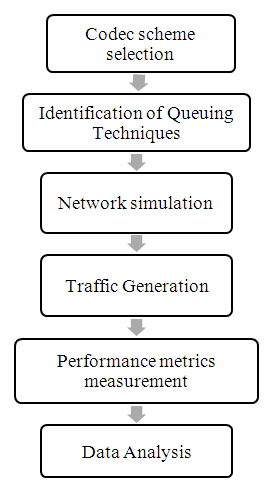 | Figure 1. Research process |
3.2. Simulation
Researchers have used the simulation technique to develop new networks or test, modify, and optimize existing ones. The simulation process creates a theoretical representation of an already existing or proposed system to identify and understand the controlling factors of the system and to predict the behavior of the system [17]. Simulations aid network designers test designed models on a platform that replicates the real environment. The behavior of the simulated network or system can be studied to predict its strengths and weaknesses before implementing the model in a real environment [18]. In this research, the OPNET Modeler 14.5 was used to simulate a model of the network under investigation.
3.3. Network Model
The type of network chosen for this research is a wired local area network supporting three different types of network traffic namely: File Transfer Protocol (FTP) traffic, Video conferencing traffic, and VoIP traffic. The network was set up as shown in Figure. 2. While maintaining the same topology and traffic of the network, different types of codec schemes and queuing techniques were tested resulting in different scenarios. Two codec schemes have been used with four different queuing techniques creating eight scenarios in the simulator.  | Figure 2. Network Model |
3.4. Network Configurations
Three applications were configured namely; the Ftp application, the the Video application, and the Voice application as shown in the table.Table 1. Application Definition
 |
| |
|
The queuing profiles that are defined in the QoS node were kept in their default settings and shown in Table 2.Table 2. Queuing profiles in the QoS node
 |
| |
|
4. Results and Analysis
This section presents the outcomes of the study, the findings have mainly been presented in the form of graphs and tables as shown below. The parameters considered were end-to-end delay, traffic sent, and traffic received. Note that all graphs shown are in time average presentation.
4.1. Impact on the Performance of File Transfer Protocol Traffic
These results show how different codec schemes and queuing techniques affect the performance of Ftp traffic in a network.
4.1.1. The G711 Codec and Queuing Techniques
Figures below show the amount of File transfer protocol (Ftp) traffic that was sent and received under G711 for FIFO, PQ, WFQ, and CQ.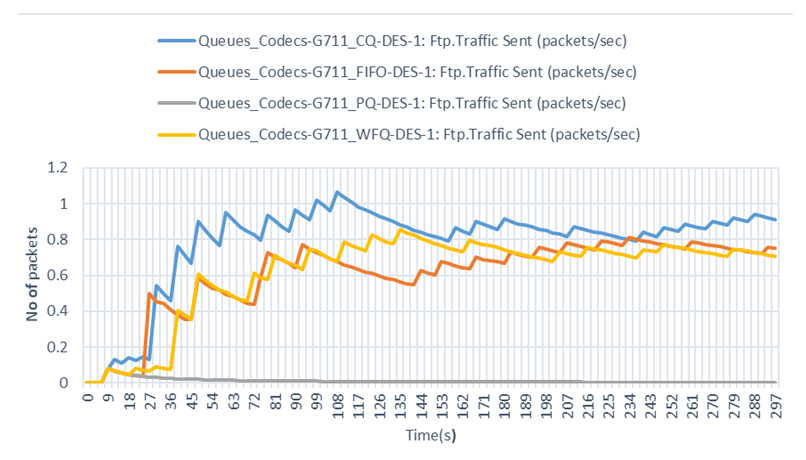 | Figure 3. FTP traffic sent under G711 |
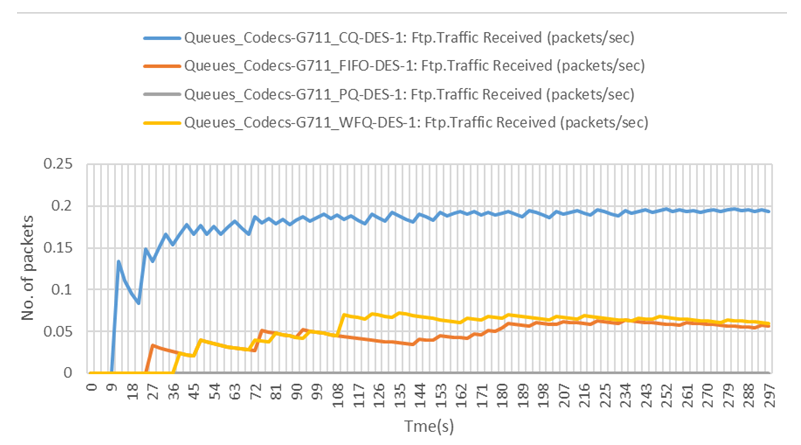 | Figure 4. Ftp traffic received |
Figures 3 and 4 show that under the G711 codec scheme, the highest amount of Ftp traffic was sent and received under the custom queuing discipline while priority queuing recorded the least. The performance of FIFO and WFQ was observed to be close with WFQ performing slightly better.Table 3. Summary Of Ftp Traffic Parameters Under G711 (Average)
 |
| |
|
4.1.2. The G729 Codec and Queuing Techniques
Figures below show the amount of File transfer protocol (Ftp) traffic that was sent and received under G729 for FIFO, PQ, WFQ, and CQ.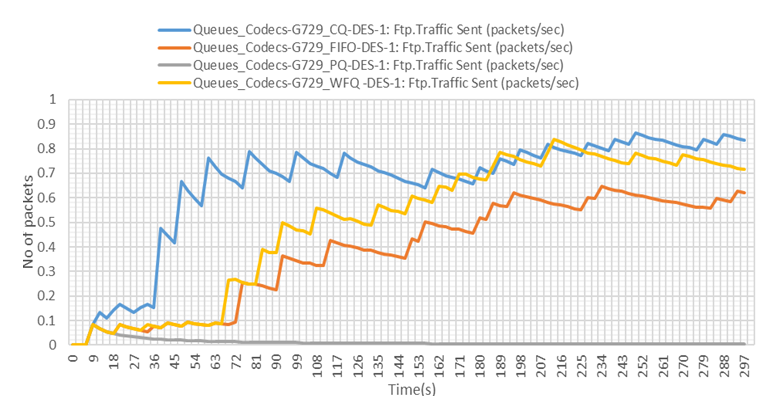 | Figure 5. FTP traffic sent under G729 |
 | Figure 6. FTP traffic received under G729 |
CQ performed the best in both the amount of FTP traffic that was sent and received across the network. The lowest amount of traffic sent and received was under PQ discipline as shown in Figure 5 and Figure 6. It was also observed that WFQ and FIFO received no packets for the first sixty (60) seconds despite traffic being sent.Table 4. Summary Of Ftp Traffic Parameters Under G711 (Average)
 |
| |
|
4.2. Impact on the Performance of Video Conferencing Traffic
These results show the impact that the use of VoIP codec schemes and queuing techniques have on the performance of video conferencing traffic.
4.2.1. The G711 Codec and Queuing Techniques
Figure 5 and Figure 6 show the packet end-to-end delay and traffic received respectively.Video conferencing packet end-to-end delay was measured with WFQ experiencing the highest delay while CQ performed the best by having the lowest delay as shown in Figure 7. | Figure 7. Video conferencing end-to-end delay under G711 |
It can be observed that WFQ received the highest number of packets in the first thirty (30) seconds of the simulation and thereafter the amount dropped to be below that of FIFO. Both PQ and CQ recorded poor results with CQ having the lowest number of packets received.Table 5. Summary Of Video Traffic Parameters Under G711
 |
| |
|
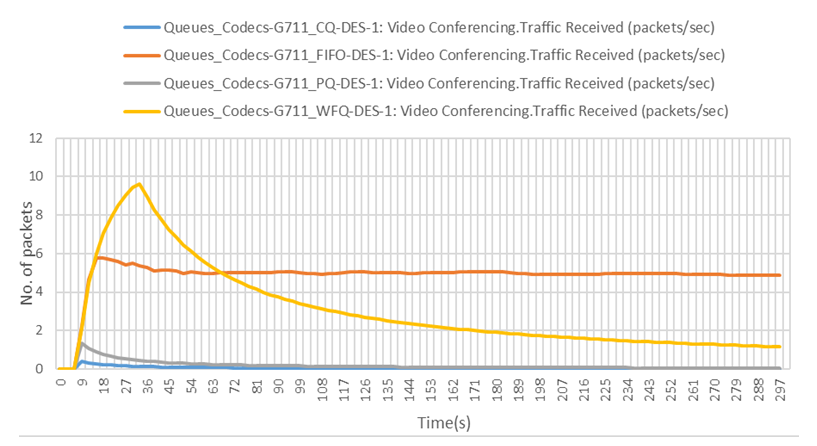 | Figure 8. Video conferencng traffic received |
4.2.2. G729 Codec Scheme and Queuing Techniques
The figures in this section show the packet end-to-end delay, traffic sent and traffic received respectively.Figure 9 shows that WFQ suffered the highest delay followed by FIFO queuing. Both PQ and CQ recorded low delays of not more than 0.3 seconds on average. CQ experienced the least delay | Figure 9. Video conferencing end-to-end delay under G729 |
The number of video conferencing packets sent per second was the same for all queuing disciplines therefore, the graph in Figure 10 appears to have a single line only.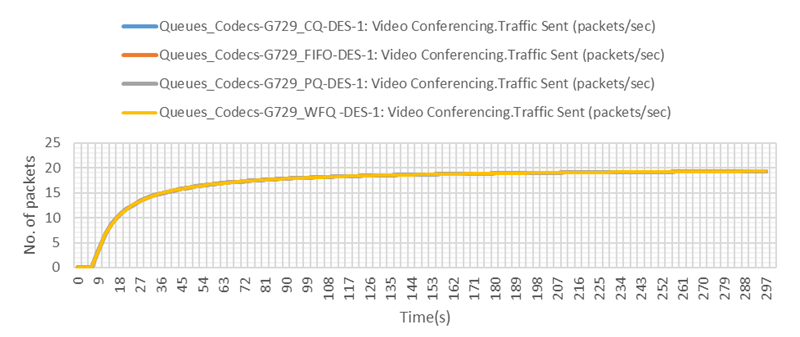 | Figure 10. Video conferencing traffic sent |
According to Figure 11, WFQ received the highest number of packets in the first thirty (30) seconds of the simulation, and thereafter the amount dropped to be below that of FIFO. Both PQ and CQ recorded poor results with CQ having the poorest performance.Table 6. Summary Of Video conferencing Traffic Parameters Under G729
 |
| |
|
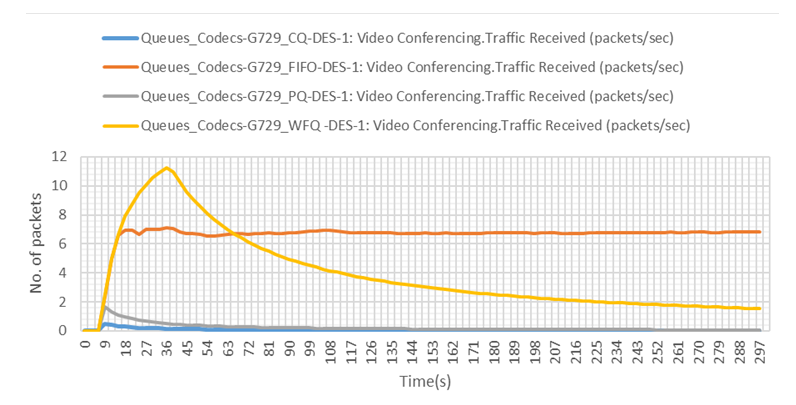 | Figure 11. Video conferencing traffic received |
5. Discussion
5.1. Ftp traffic
FTP traffic was seen to perform the best under custom queuing for both codec schemes with a slight improvement in the throughput for G729. Since custom queuing assigns a percentage of available bandwidth to each queue and works in a round-robin fashion, moving from queue to queue, ensures that each is allocated their apportioned bandwidth. This ensured that FTP traffic did not suffer from starvation despite it not being a real-time application. It has already been established that G729 utilizes bandwidth more efficiently as compared to G711, hence the improvement in throughput.Priority queuing performed the worst under both codec schemes as no packets arrived at the receiver’s end despite traffic being sent. This is what was referred to as starvation in [19]. For FIFO and WFQ, it was observed that despite traffic being sent no packets arrived at the receiver’s end for some time (about 27 sec in G711 and 60 sec in G729). The reason for this delay could be that both queuing techniques suffered from packet losses and since FTP uses TCP, retransmission was requested causing a delay in the receipt of packets at the receiving node [9]. Transmission under G729 involves compression delay unlike in G711 which extends to the total delay. Hence the longer period of 60 seconds is observed in G729.
5.2. Video Conferencing Traffic
Custom queuing received the least amount of video conferencing traffic but also suffered the least delay. It was expected that since the queuing technique experienced the least amount of delay, it would receive higher amounts of traffic than the rest of the queuing techniques. The explanation for the poor throughput may be that most packets were dropped because of inadequate bandwidth assigned to the queue. The high end-to-end delay observed in WFQ corresponds with the results recorded in [8] and may have been due to the waiting time that packets experience while other queues are being serviced. The higher the weights assigned the longer the wait (delay). WFQ has been reported to receive the highest video traffic in [14] unlike what has been observed in the results where FIFO has recorded higher than WFQ.
ACKNOWLEDGEMENTS
Special thanks go to Dr. Simon Tembo my supervisor and Dr. Lukumba Phiri for their support and input during the research. I wish to thank my family for their support during this period but most of all, God for the strength and good health during study.
References
| [1] | D. Wu “Performance Studies of VoIP over Ethernet LANs”, Dissertation School of Computing and Mathematical Sciences, Auckland University of Technology, 2008. |
| [2] | P. Luthra, M. Sharma, “Performance Evaluation of audio codecs using VoIP traffic in Wireless LAN using RSVP, pp.15-21, 2012. |
| [3] | H. S Mewara and D. Manghnani, “Comparative Analysis of VoIP Application with Different Queuing Schemes in WiMAX Using OPNET”, IEEE International Conference on Computational Intelligence & Communication Technology, pp. 475-481, 2015. |
| [4] | A. S. Gillis, “Codec”, TechTarget, https://www.techtarget.com/searchunifiedcommunications/definition/codec, [Accessed 28/11/2019] |
| [5] | C. Semeria, “Supporting Differentiated service classes: Queue scheduling disciplines”, Juniper Networks Inc, pp 11-44, 2001. |
| [6] | A. Karim, “VoIP Performance Over different service Classes Under Various Scheduling Techniques”, Australian Journal of Basic and Applied Sciences, pp 1416-1422, 2011. |
| [7] | S. Szilágyi, B. Almási, “A Review of Congestion Management Algorithms on Cisco Routers”, Journal of computer science and control systems, pp 103, 2012. |
| [8] | H.R.D AL-Fayyadh, “Assessment of the Impact of Different Queuing Techniques on Different Network Traffic Services”, Journal of Software Engineering and Simulation, pp. 7-15, 2022. |
| [9] | B. Herath, “TCP/FTP Queue Size and Packets Drop Performance Simulation Using NS2”, 2015. |
| [10] | R. Rahim, et al. "Prototype file transfer protocol application for LAN and Wi-Fi communication." Int. J. Eng. Technol, 2018. |
| [11] | S. Brey, F. Borko, "Videoconferencing systems and applications." Handbook of Internet Computing, pp. 451-484. CRC Press, 2019. |
| [12] | A. Saurin, “Congestion control for video-conferencing applications”. University of Glasgow (United Kingdom), 2006. |
| [13] | K. Balasundaram, T. Velmurugan and R. Suresh, “Performance Analysis of Queuing Disciplines for Difference Services Using OPNET Tool”, International Journal of Scientific Engineering and Technology, pp.47-50, 2014. |
| [14] | M. Gospodinov, “The effects of different queuing disciplines on packet delivery for FTP, Video and VoIP”, CompSysTech, pp 1-5, 2004. |
| [15] | M. Mustafa, S.A Talab, “The Effect of Queuing Mechanisms First in First out (FIFO), Priority Queuing (PQ) and Weighted Fair Queuing (WFQ) on Network’s Routers and Applications”. Wireless Sensor Network, 08, pp77-84, 2016. |
| [16] | M. Kaufmann, “Deploying QoS for Cisco IP and Next Generation Networks,” Elsevier Inc., pp 23-70, 2009. |
| [17] | A. Musa, I. Awan, “Functional and performance analysis of discrete event network simulation tools”, Simulation Modelling Practice and Theory, 2022. |
| [18] | A. A Samra, “Performance Evaluation of the QoS for VoIP using Different CODECS”, International Journal for Research in Applied Science & Engineering Technology (IJRASET), vol.5, 2017. |
| [19] | A. Balchunas, (2010), “QoS and Queuing”, http://www.routeralley.com,v1.31. |














 Abstract
Abstract Reference
Reference Full-Text PDF
Full-Text PDF Full-text HTML
Full-text HTML




